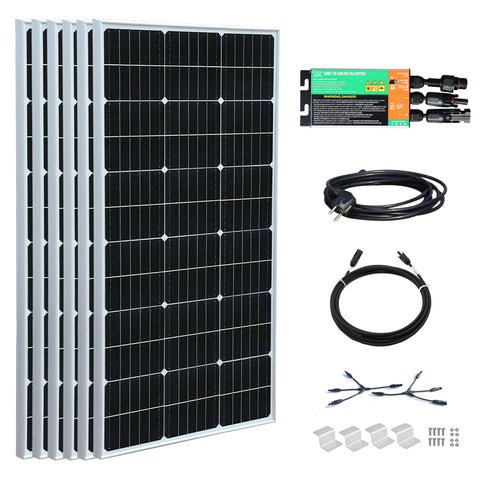
Ten frequentely asked questions about RV solar panels

Many solar beginners have confused about many questions about RV solar panels. In this article, we summarized ten frequently asked questions about RV solar panels to clear out your confuse in your mind. Let`s have a look!
1: Use solar power VS An Ac generator
Unlike an AC generator, a solar-power system has no moving parts, makes no noise or smell and requires little maintenance. A solar system will likely double or triple the life of your RV batteries and if you add an inverter you can have AC power while dry camping without the everpresent hum of your AC generator. It can be cost-effective in the long run and a solar system can be sized to suit your needs, whether that’s just keeping a single battery charged or maintaining a large battery bank for running all the modern conveniences of a large fifth-wheel.
2: What makes up an RV solar power system?
A basic RV solar power system consists of one or more solar panels to generate charging current, a charge controller, batteries and ancillary components such as brackets, mounting hardware and wiring.
3: What are types of solar panels?
There are three basic commercially available types of photovoltaic material:
Amorphous silicon Monocrystalline silicon Polycrystalline silicon
The monocrystalline & polycrystalline silicon are the most common.
4: How do solar panels work?
The cells have a positive and negative side. The middle, where electrons are held, is called the P-N junction. When light strikes the surface of the cells, the electrons become excited and begin generating pure DC (direct current) electricity. The number and size of the cells that are connected in series control the amount of voltage and amperage created. Each cell has a potential voltage of about 0.5 volt, so roughly 1 volt is produced per two cells in series.
5: What is the minimum number of cells needed?
You need a minimum of 36 standard cells in series to develop enough voltage to fully charge a battery. We recommend a 160 watt solar panel for every two batteries you want to charge. That may seem like a lot of voltage to charge two 12-volt batteries, but there are factors that affect output (such as the intensity of the sunlight, amount of shade, cell temperature, angle of sunlight, etc.) that must be compensated for.
6: Why use charge controllers?
A charge controller’s purpose is to prevent the solar panels from overcharging the batteries. We use a series controller with pulse-width modulation, it uses a series element that is switched on and off at a variable frequency with a variable-duty cycle to maintain the battery at the voltage-regulation point. In plain English, that means it will charge the batteries up to a preset voltage-regulation set point, then taper off the charging current from the solar panels. This strategy maintains the highest state of charge with the least amount of water consumption.
7: What battery is recommended for my RV?
We recommend a deep-cycle battery for your RV, not a typical automotive starting battery. A deep-cycle RV or marine battery can withstand repetitive discharges of up to 50 percent or more and still continue to provide its rated capacity after hundreds of cycles. This characteristic, combined with more reserve capacity, makes deep-cycle batteries ideal for use in an RV application.
8: What do I do if I need more power?
If you need more power, you can upgrade to bigger batteries, if they’ll fit. You’ll want batteries with the highest amp/ hour (ah) rating that is available. For those with more demanding power needs, adding 12-volt batteries and connecting them in parallel will double the amount of time before the batteries are discharged. If your RV has the room, you may want to opt for 6-volt golf-cart batteries, connected in series to produce 12 volts. This setup can endure more deep discharges than a 12-volt RV/marine product (sometimes twice as many) and is popular with those who only operate their RVs through an inverter on battery power. Remember that parallel connection combines amps, not voltage, and series connection combines voltage, not amps.
9: What are popular types of RV batteries?
There are several types of batteries on the market today.
·Flooded-cell batteries, or those using water as the electrolyte, remain the most widely used, primarily because they are inexpensive, work well in a variety of applications and have a good service life (when properly maintained).
·Gel-cell batteries are also a flooded-cell battery, but one in which silicates have been added to the electrolyte material to make it a gel.
These batteries fall into the sealed-lead acid (SLA) or maintenance-free category, but should not be confused with Absorbed Glass Mat (AGM) batteries, which are often incorrectly referred to as gel-cell batteries.
10:How do I know the number of solar panels to charge?
·Assuming you use your RV primarily during the spring and summer like most of us, you’ll be exposed to an average of five peak-sun-hours a day.
·A 160-watt panel produces an average of about 10 amps per peak-sun-hour, or about 50 amp-hours a day.
·So, in our example, you would need one160-watt solar panels to fully recharge on an average day.
·The average RVer consumes between 75 and 150 amp-hours of energy a day; thus, one to three 160-watt panels would be required to break even on a daily basis.
To learn more about RV solar panels, please follow XINPUGUANG official website:
Facebook: Xinpuguang Solar Panel
Instagram: xinpuguangsolar
Pinterest: XinpuguangSolarPanels
Homepage: https://xinpuguangsolar.com
Email address: Philip@isolarparts.com

- Als u een selectie kiest, wordt de pagina volledig vernieuwd.

